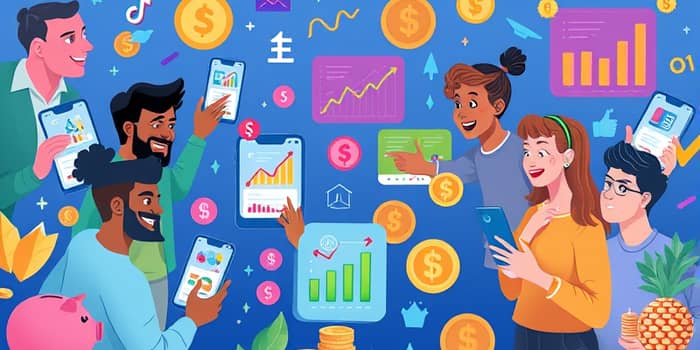Embarking on a journey to financial security starts with understanding the basics of money management. For many beginners, complex terminology and abstract concepts can be overwhelming.
Fortunately, a new wave of apps offers breaking down complex financial topics into approachable, bite-sized lessons. These tools fit into busy routines, transforming waiting times into opportunities for growth.
Why Financial Literacy Matters
Financial literacy is more than just balancing budgets; it empowers individuals to make informed decisions that shape their futures. Without proper knowledge, people risk accumulating debt, missing investment opportunities, or falling prey to high-interest traps.
By cultivating building consistent, disciplined financial habits, beginners can navigate challenges like student loans, rent payments, and emergency expenses with confidence. Early education lays the groundwork for long-term stability and wealth creation.
Types of Financial Literacy Apps
Financial literacy apps come in various forms to suit different learning preferences and goals. Understanding these categories helps users select the right tool for their needs.
- Educational platforms that focus on theory through interactive modules.
- Budget and expense trackers that link to bank accounts for real-time monitoring.
- Investment learning apps offering strategy guides and market overviews.
- Family-oriented programs teaching children and teens money management.
- Gamified systems using competition and rewards to boost engagement.
Top Financial Literacy Apps for Beginners
Below is a summary of standout apps, each designed to tackle different aspects of financial education and management.
Zogo leads with over 300 lessons across 20 categories and a system that rewards progress through partner offers. It turns learning into a series of achievements, offering bite-sized modules with real rewards.
Mint provides a consolidated view of financial status by linking bank and credit accounts. Users create budgets, track expenses, and monitor credit scores, though occasional syncing challenges may arise.
Finaciti excels at interactive quizzes and practical exercises, guiding users through budgeting, investing, and retirement planning with a goal-setting feature. It’s ideal for those craving personalized advice.
Money Masters adds friendly competition to learning, offering gamified lessons on economics and investing. Participants practice strategies without real-money risk, earning high ratings for its engaging format.
YZER targets budding investors with quick, visual tutorials on blockchain, markets, and technical analysis. It’s a free resource where learners can also win rewards for demonstrating new skills.
Simplifi and Digit both automate financial planning. Simplifi crafts personalized, goal-oriented spending plans based on real income and bills, while Digit allocates funds across bills, savings, and investment buckets.
For families, FamZoo, Rooster Money, and MyMonii offer parent-supervised virtual banks, chore tracking, and allowance management. They teach children through hands-on experience and digital rewards.
Your Juno supports women’s financial growth via expert-led courses and community forums, while Ascendr pairs learners with mentors for tailored coaching in finance and investing.
How Apps Enhance Learning
These apps transform passive reading into active engagement. By offering real-world examples and practical tips, they help users apply concepts immediately to their finances.
Gamification elements such as points, badges, and leaderboards create motivation loops, encouraging consistent participation. Interactive content and progress tracking ensure learners stay on target and celebrate milestones.
Moreover, many platforms integrate with external resources, linking to calculators, regulatory guidance, and expert material. This synergy fosters a holistic understanding of personal finance beyond the app environment.
Choosing the Right App
Selecting the ideal app depends on individual goals and preferences. Consider these factors when making your choice:
- Free vs. paid models based on your budget.
- Platform compatibility with your devices.
- Language support for non-native English speakers.
- Target audience focus such as families, women, or teens.
- Learning style preferences, from gamified challenges to in-depth courses.
Evaluate trial versions and user reviews to gauge usability and reliability. Assess whether the app’s teaching style and reward systems align with your motivation triggers.
Conclusion
Developing financial literacy is a key step toward long-term security and independence. With the right app, beginners can gain confidence through structured learning paths for all levels, transforming complex topics into manageable lessons.
Whether you want to master budgeting, explore investment strategies, or coach your family in money management, there is a tool designed to guide and inspire. Start today to build a solid foundation for your financial future.
References
- https://qonto.com/en/blog/business-management/finances/finance-apps
- https://www.purdueglobal.edu/blog/student-life/budgeting-apps-personal-finance-tools/
- https://www.kidvestors.co/post/financial-literacy-app
- https://finaciti.com/best-financial-literacy-apps-2023-improve-money-management/
- https://economictimes.com/wealth/invest/6-apps-that-can-boost-your-financial-literacy/articleshow/102851709.cms
- https://www.clearmountain.bank/community/community-engagement/zogo
- https://www.annuity.org/financial-literacy/
- https://www.nimbleappgenie.com/blogs/financial-literacy-apps/










